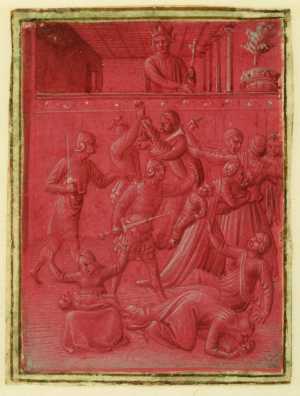Specifications
| Title | The Massacre of the Innocents |
|---|---|
| Material and technique | Brush and brown ink, white bodycolour, on red-violet prepared parchment |
| Object type |
Drawing
> Two-dimensional object
> Art object
|
| Location | This object is in storage |
| Dimensions |
Height 75 mm Width 60 mm |
|---|---|
| Artists |
Attributed to:
Zanobi Strozzi
Previously attributed: Fra Angelico |
| Accession number | I 234 (PK) |
| Credits | Loan Stichting Museum Boijmans Van Beuningen (former Koenigs collection), 1940 |
| Department | Drawings & Prints |
| Acquisition date | 1940 |
| Creation date | in circa 1450-1455 |
| Inscriptions | '234 / 4' (verso, below center, pencil) |
| Collector | Collector / Franz Koenigs |
| Mark | F.W. Koenigs (L.1023a) |
| Provenance | Sale Count A. de Robiano, Brussels (and others), Amsterdam (Mensing) 05-06.07.1927, lot 249 (Miniaturist A, Florentine, c. 1450, with 9 other drawings, Fl 5600); Franz W. Koenigs (1881-1941, L.1023a), Haarlem, acquired in 1927 (Florentine, c. 1450, with 6 other drawings); D.G. van Beuningen (1877-1955), Rotterdam, acquired with the Koenigs Collection in 1940 and donated to Stichting Museum Boijmans Van Beuningen |
| Exhibitions | Montefalco 2002, no. 6.(1); New York 2005, no. 47A; Rotterdam 2009 (coll 2 kw 4); Rotterdam (Rondom Fra B.) 2016 |
| Internal exhibitions |
De Collectie Twee - wissel IV, Prenten & Tekeningen (2009) Rondom Fra Bartolommeo (2016) |
| Research |
Show research Italian Drawings 1400-1600 |
| Literature | General (inv. I 234-240): Berenson 1938, vol. 2, no. 175 (copies after Fra Angelico by Umbrian follower); Mongan/Sachs 1946, p. 6, under no. 2 (attr. Z. Strozzi); Berenson 1961, pp. 35-36; Orlandi 1964, p. 161 (style of Fra Angelico); Pasionario 2007, ill. Specificific (inv. I 234): Amsterdam 1934, no. 455 (Florence, c. 1450, inv. I 234); Degenhart/Schmitt 1968, vol. I-2, no. 374, vol. I-4, pl. 309a (Fra Angelico school); J. Bober in Mongan/Oberhuber/Bober 1988, p. 86, under no. 4a-b; Boskovits 1995, p. 59 n. 26; Boskovits in Montefalco 2002, no. 6 (1), ill. (attr. Fra Angelico); Palladino in New York 2005, no. 47A, ill. (Z. Strozzi) |
| Material | |
| Object | |
| Technique |
Prepare
> Prepared
> Shaping techniques
> General technique
> Technique
> Material and technique
Prepare
> Prepared
> Shaping techniques
> General technique
> Technique
> Material and technique
|
| Geographical origin | Italy > Southern Europe > Europe |
| Place of manufacture | Florence > Tuscany > Italy > Southern Europe > Europe |
Do you have corrections or additional information about this work? Please, send us a message

























